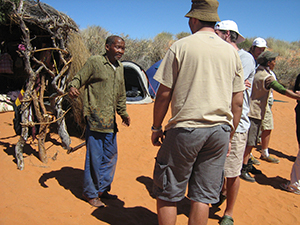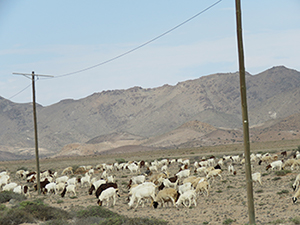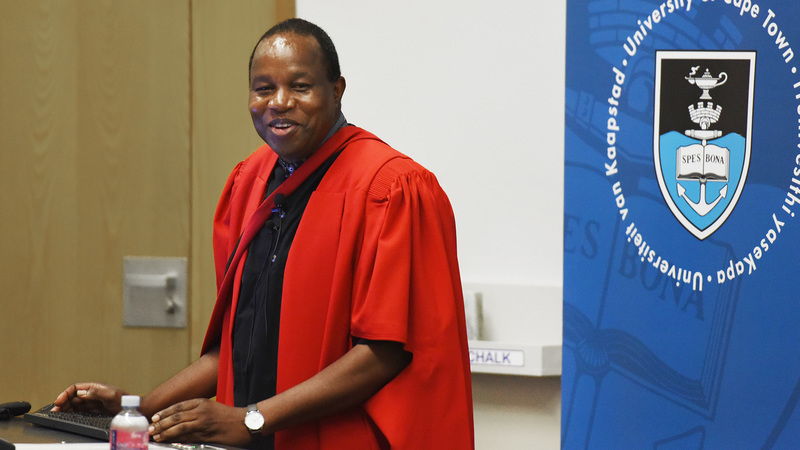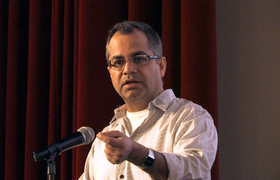Peace parks: the future of Africa’s natural resources
13 March 2018 | Story Helen Swingler. Read time 9 min.Peace parks have a long history in Africa, bound up in colonialism, border politics and, currently, land claims in South Africa. But the parks also have implications for the ownership and control of natural resources, said Professor Maano Ramutsindela in his recent inaugural lecture, “Remapping Africa through peace parks: What future for the continent?”
The establishment of peace parks – also known as transfrontier conservation areas – along African countriesʼ borders were more than an approach to jointly manage natural resources across political boundaries. They were cartographic devices used by colonial powers to control resources in Africa. And the use of these devices in post-independence Africa has implications for the ownership of resources among communities who live in these regions, particularly concerning the land.
Redefined national borders
Most peace parks between South Africa and its neighbouring countries have illustrated that they redefined national borders for wildlife, which becomes the common property of the participating countries.
But the shared implications for ownership of the resources for the communities that live in these regions poses a different challenge. Historically, these communities were groups with shared ethnicity, language and heritage, who were not bound by the colonially drawn map.
For real decolonisation to happen now the short-term goal should be to create a fluid movement of people within transfrontier parks and to give these communities access to trans-border natural resources, said Ramutsindela of the Department of Environmental and Geographical Sciences.
He expressed this idea in the New York Times Sunday Review ‘Room for Debate’ (4 July 2014), writing: “… the Kgalagadi, the first official transfrontier park in post-independence Africa, is the historical home of the southern San community in Botswana, Namibia and South Africa. But the San – part of the Khoe-San language group – struggle to cross borders to work and visit family, even though wildlife and tourists roam freely in the park, entering all three nations.
“Even without redrawing the borders of Botswana, Namibia and South Africa, the nations could acknowledge that the Kgalagadi micro-region represents the land of the San. They [the San] should think of themselves, and live their lives, as transnational citizens.”
Instead, what happens when you visit peace parks such as the Kgalagadi?

“Here is Oom Dawid,” Ramutsindela said, showing a slide of Dawid Kruiper with a group of UCT students. Kruiper made the news in 1999 when he and his clan won a land claim, settling for 25 000 hectares of land on the outskirts of the park.
“I took my students to see what peace parks mean to the Khomani San. When we said we’d come to visit the peace parks, they asked, ʻWhose peace are we talking about?’
“We couldn’t answer that question because while this peace park was established on their land, we were told that their visitors from Botswana and Namibia that day had to hide each time tourists passed because tourists don’t want to see people. This brings back the question of the land and the implications of the peace parks in terms of the land issue.”
Maps organising society
From early in his career as a human geographer, Ramutsindela was interested in the idea of the map and how it organises society
“I started researching peace parks in 2001 for one reason: because it was claimed they were going to decolonise Africa. Well, I’d always wanted to do this,” he quipped. “I thought at least for the first time we have an instrument to do so.”
Ramutsindela began his peace park research on an upbeat note: there were new things happening; the project was supported by people like former President Nelson Mandela and many others were interested. But there were also sceptics who saw the emergence of peace parks, “green spots on the map”, as something that would change the face of Africa. Greening Africa became a very important part of the peace parks project.
“As we know, conservation was part of the partitioning of Africa and we often forget about this because we’re interested in saving the rhinos and other big animals. But what is important to understand is the relationship between Africa and colonial conservation.
“If we look at some of the colonial maps we might think these were different from the British Empire’s project in Africa. In East Africa there was a concentration of British citizens and in that concentration you saw the emergence of national parks. If one thinks of these as British national parks for Africa, where are the African parks themselves?
“So, one has to think about where they come from. I also want to suggest that the sites we see as peace parks today were there in the 1930s. If we take the famous Kruger Park you see that these parks were beginning to cross boundaries as early as 1935. We can’t say these cross-border peace parks are post-94. We have to retrace the historical lineage. I’m not a historian but I now have to go to the archives to dig out these maps so I can try to understand what happened before.”
Big business
Ramutsindela also dispelled the idea that national parks were located to protect the wildlife found in these regions.
“But if one reads the history of organisations such as the Southern African Nature Foundation (SANF), we see that often animals were translocated into some areas, which were seen by the SANF as important in building conservation areas.”
Businessmen such as Anton Rupert were very influential in developing the current peace parks. And investment by companies like Rembrandt allowed them to become very involved in translocating animals. Ramutsindela found that some were investing in this process as a show of faith in a future South Africa. Even at the height of the struggle against apartheid there was a steep increase in the number of corporates supporting conservation.
“There could be many reasons for this; I’m just showing what the data suggests,” he said.
Peace after the Cold War
Another important factor in the rise of peace parks was the end of the Cold War when many NGOs got involved in “parks for peace”. The tourism industry came on board as well, to promote tourism for peace. The end of the Cold War also saw a resurgence in the discussion about African borders.
“Most African scholars were arguing that Africa was not free until the borders were removed,” said Ramutsindela. “This was an opportunity for proponents of peace parks to say: we can remove the borders through conservation … And if the project went further, it could radically decolonise Africa, allowing micro-regions to inspire a new map.”
“And if the project went further, it could radically decolonise Africa, allowing micro-regions to inspire a new map.”

These micro-regions evolved from existing connections and ecosystems. They could also be formalised as transnational conservation areas, or they could be informal if governments were hesitant to commit to an international treaty. Nonetheless, the development and recognition of micro-regions was good for humans and ecosystems, Ramutsindela said, because they gave residents on both sides of the border a collective voice in governing the natural resources.
“As more micro-regions are established and respected, these will be a stepping stone towards regional integration in southern Africa.”
Land claims
Peace parks create some discomfort, he said. One of the major discussions about peace parks centres on land claims in South Africa and land and resource rights in the transfrontier park regions.
“There is all this contested terrain about resources and who owns what. Do you give people their land back in an area which is a peace park?” he asked. “There is a sense that the creation of peace parks affects the way we do land reform in South Africa – and it has already in the test areas. Land claimants in areas designated for peace parks will find it hard to get their land back. One successful land claimant in Mapungubwe has vowed to resist attempts to incorporate their land into the peace park.”
 This work is licensed under a Creative Commons Attribution-NoDerivatives 4.0 International License.
This work is licensed under a Creative Commons Attribution-NoDerivatives 4.0 International License.
Please view the republishing articles page for more information.











